Configuring complex products shouldn’t be a complex process
Legacy quoting systems are costing businesses millions in lost revenue, delayed deals, and operational inefficiencies. The CPQ market has exploded to $1.7 billion in 2024 and is projected to reach $3.41 billion by 2030, driven by companies desperate to modernize their complex product configuration processes. Organizations stuck with rigid, manual quoting systems face 3x longer quote generation times and 40% higher error rates compared to those using intelligent, constraint-based CPQ platforms. The path forward isn’t just about technology—it’s about reimagining how your revenue operations scale in an increasingly complex product landscape.
Ready to see how modern CPQ can transform your quoting process? Schedule a personalized demo to discover how companies achieve 3x faster quote generation with Mobileforce’s intelligent platform.
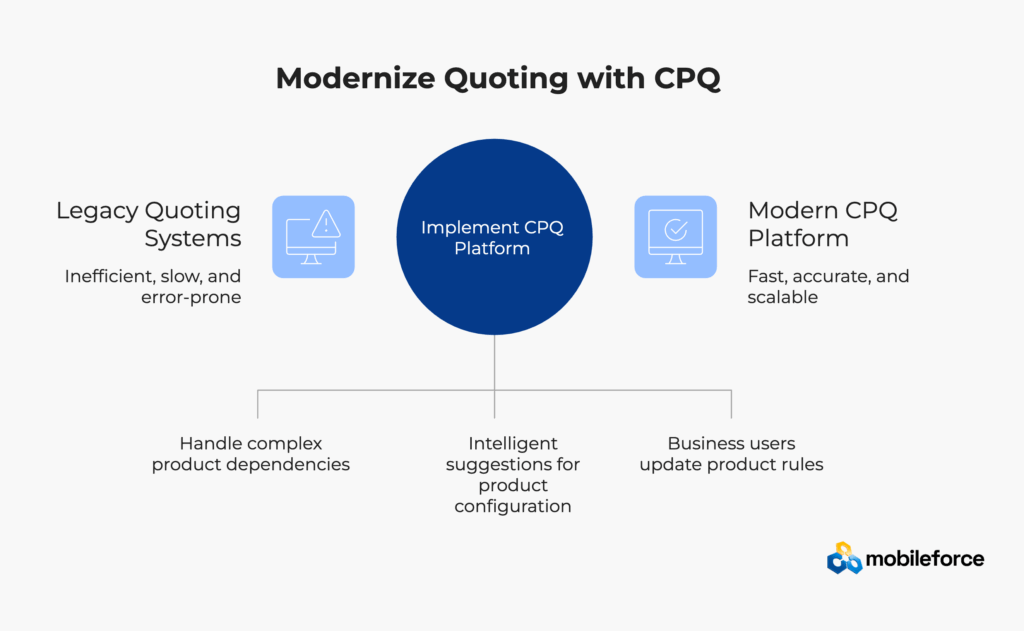
The story always starts the same way. A promising deal sits in the pipeline, the customer is ready to buy, and then… silence. Your sales rep is stuck waiting for engineering to validate a complex product configuration. The pricing team needs three days to calculate margins on a custom bundle. Legal wants to review contract terms that should be standard by now.
Sound familiar? You’re not alone. According to recent industry research, companies using outdated quoting systems lose an average of 27% of potential deals due to lengthy quote processes, while organizations with modern CPQ platforms close deals 3x faster.
The explosion in product complexity across industries has transformed quoting from a simple process into a strategic bottleneck. Whether you’re selling configurable software, custom manufacturing equipment, or complex service bundles, the constraints of legacy quoting systems are becoming impossible to ignore.
Picture this: a customer wants to configure a piece of industrial equipment with 15,000 possible component combinations, each with different lead times, pricing tiers, and regulatory requirements across six countries. That’s Tuesday morning for many manufacturers.
Product complexity has evolved far beyond simple SKU management. Today’s configurations involve intricate webs of dependencies, compatibility constraints, and dynamic pricing models that change based on volume, geography, customer segments, and market conditions.
Physical constraints where certain components simply cannot work together due to size, power, or engineering limitations. Regulatory compliance that varies by jurisdiction, creating configuration rules that shift based on where the product will be deployed. Dynamic pricing that adjusts based on market conditions, customer loyalty tiers, inventory levels, and competitive pressures.
But here’s what most organizations miss: complexity isn’t just about the number of options. It’s about the combinatorial explosion that happens when those options interact. A product with 100 base configurations and 50 optional features doesn’t have 150 possibilities—it has potentially millions of valid combinations and even more invalid ones that need to be prevented.
|
Configuration Type |
Traditional Approach |
Modern Constraint-Based |
|
Simple Products (< 100 SKUs) |
Rule-based systems work adequately |
Overkill but future-proof |
|
Complex Products (1,000+ SKUs) |
Breaks down, requires manual intervention |
Handles efficiently with automated validation |
|
Highly Complex (10,000+ combinations) |
Impossible to manage manually |
Thrives with AI-assisted recommendations |
The manufacturing sector alone accounts for over 40% of CPQ market revenue, driven precisely by this complexity challenge. Companies that master configuration complexity don’t just survive—they turn it into a competitive advantage.
Struggling with complex product configurations? See how Mobileforce’s constraint-based engine handles millions of combinations without breaking a sweat.
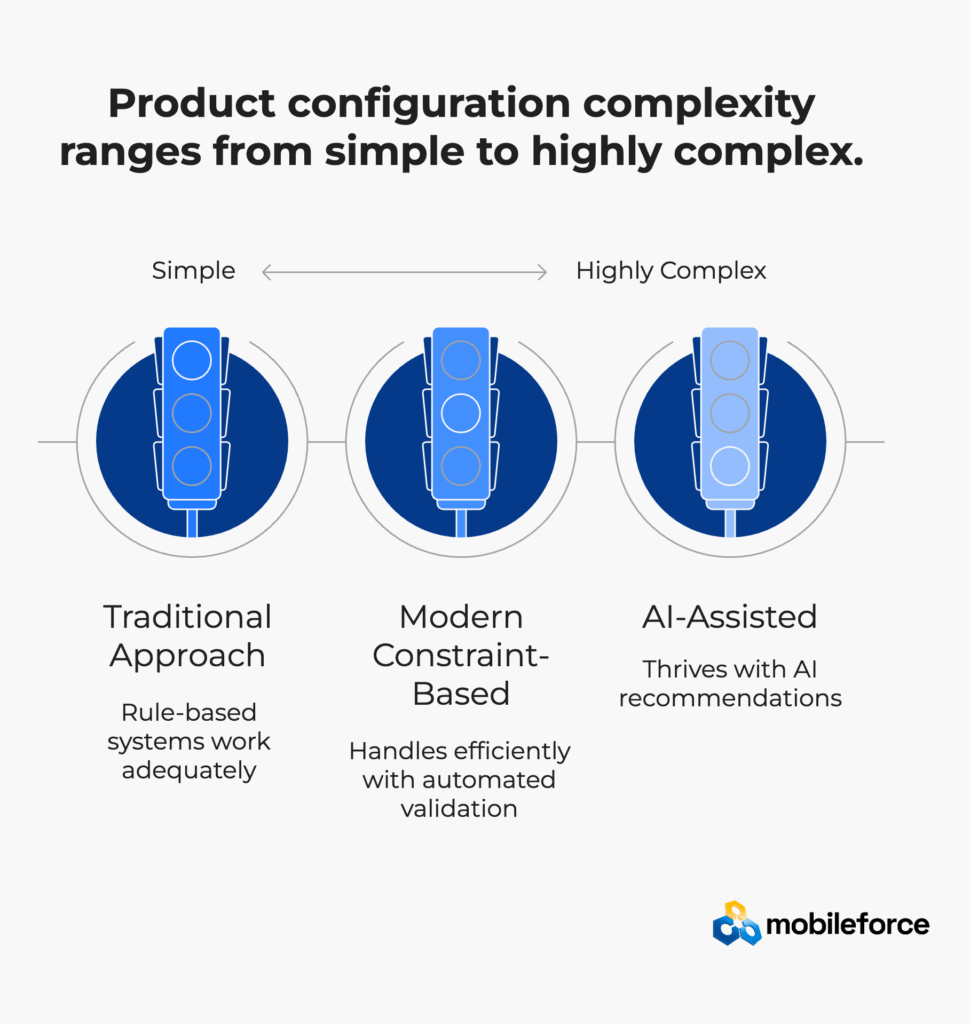
The symptoms are everywhere, but most executives don’t connect them to their quoting systems. Sales cycles that stretch longer than expected. Deals that die in the configuration phase. Customers who choose competitors because they can respond faster.
Legacy systems rely on rigid if-then rule structures that become unmanageable as product lines expand. What starts as 50 simple rules quickly balloons to thousands of interconnected conditions that no one person can fully understand. When a new product launches or regulations change, updating these rule sets becomes a nightmare that can take weeks or months.
The typical enterprise uses 12-15 different systems for the quote-to-cash process. CRM holds customer data, ERP manages inventory, pricing tools calculate margins, and contract management handles terms. Information gets lost in translation between systems, leading to inconsistent quotes and pricing errors that can cost millions.
But the real killer is time. In B2B sales, speed isn’t just convenient—it’s strategic. Research from PROS shows that the first vendor to provide a complete, accurate quote wins the deal 74% of the time, regardless of whether they have the best product or lowest price.
Consider the hidden costs:
Lost deals due to slow response times: Industry studies show that for every additional day in the quote process, close rates drop by 5-8%.
Revenue leakage from pricing errors: Manual quoting processes have error rates of 15-20%, with mistakes typically favoring the customer.
Resource drain on high-value personnel: Senior engineers and salespeople spend 40% of their time on administrative quote tasks rather than strategic activities.
Brand damage from inconsistent experiences: Customers notice when quotes vary for identical products, eroding trust in your pricing integrity.
The most insidious aspect of legacy constraints is that they’re invisible until you measure them. Organizations often don’t realize they’re losing competitive battles during the quoting phase because those losses are attributed to price or product features rather than process friction.
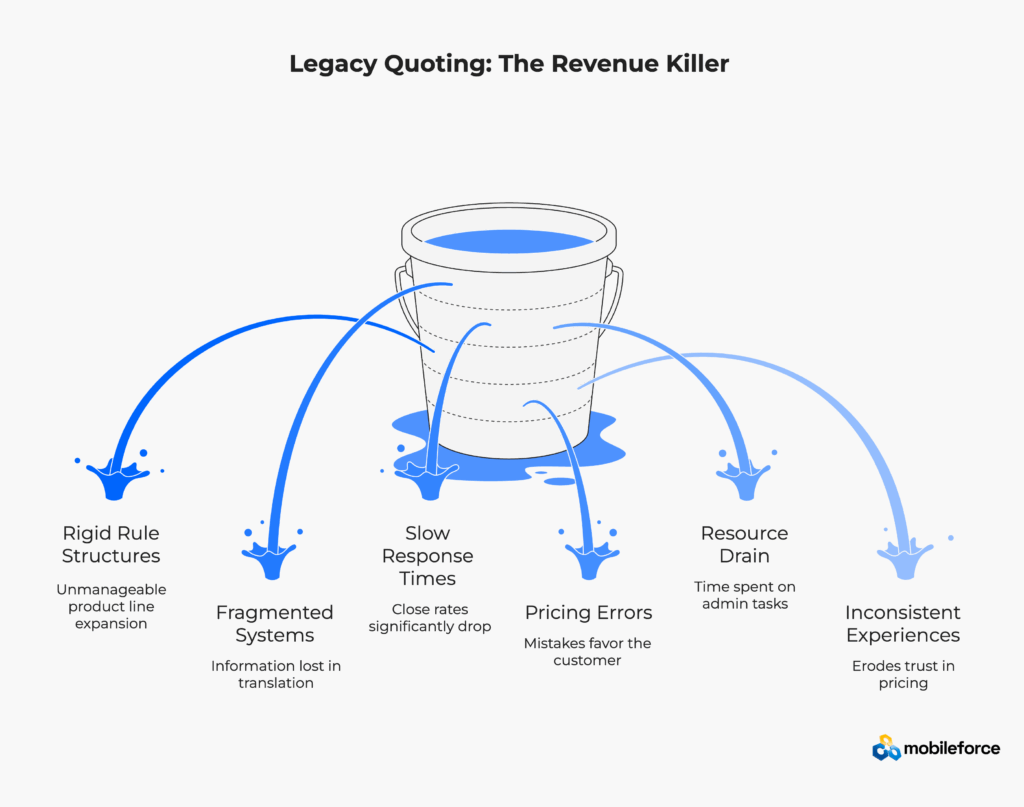
The evolution from rule-based to constraint-based configuration represents more than technological advancement—it’s a fundamental shift in how businesses think about product complexity.
Constraint-based engines work differently. Instead of trying to enumerate every possible valid combination, they define what makes configurations invalid and let the system find optimal solutions within those boundaries. It’s like the difference between providing turn-by-turn directions versus giving someone a map and destination.
This architectural shift enables capabilities that were impossible with legacy systems:
Real-time validation: As users build configurations, the system instantly highlights incompatible choices and suggests alternatives, preventing dead-end configurations before they happen.
Intelligent recommendations: AI algorithms analyze past successful configurations, customer preferences, and market data to suggest optimal product combinations that customers might not have considered.
Dynamic constraint application: Rules change automatically based on context—customer location triggers regional compliance requirements, order volume unlocks volume discounts, and seasonal factors adjust availability.
The integration advantages are equally compelling. Modern CPQ platforms don’t just connect to other systems—they become the central nervous system for revenue operations, pushing configuration data to ERP for manufacturing, pricing data to finance for margin analysis, and contract terms to legal for compliance review.
|
Capability |
Rule-Based Legacy |
Constraint-Based Modern |
|
Configuration Speed |
Minutes to hours |
Seconds to minutes |
|
Error Rate |
15-20% |
Under 2% |
|
Time to Add New Products |
2-6 weeks |
1-3 days |
|
Rule Maintenance |
Expert required |
Business user friendly |
|
Integration Complexity |
High custom coding |
Pre-built connectors |
Mobileforce’s no-code platform exemplifies this evolution, enabling business users to configure complex product rules without technical expertise while maintaining enterprise-grade performance and security.
Curious about the difference constraint-based configuration can make? Get a personalized demo and see your actual product catalog running on Mobileforce’s intelligent platform.
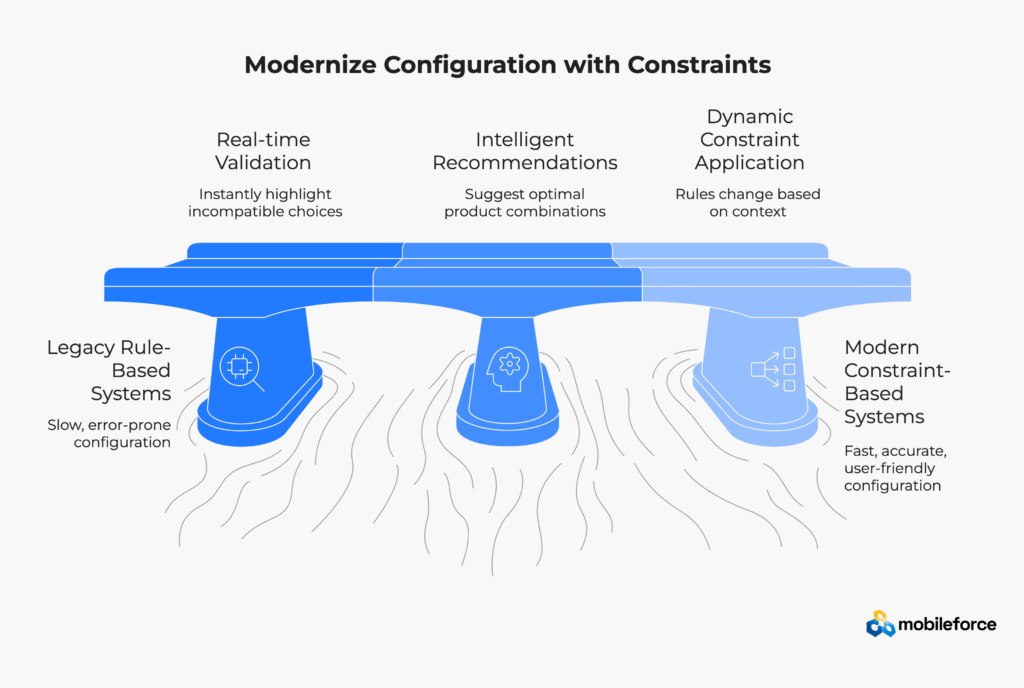
Migration anxiety is real. The fear of disrupting critical revenue processes keeps many organizations locked into suboptimal systems long past their useful life. But the companies that execute thoughtful migrations don’t just improve their processes—they often discover revenue opportunities they never knew existed.
Most migration projects fail because organizations underestimate the complexity embedded in their current systems. Start with a brutal audit of your existing quoting process. Map every step, every system handoff, every manual intervention. Time how long quotes actually take from initiation to customer delivery, not just the “happy path” scenarios.
The audit often reveals shocking truths. One manufacturing company discovered their “two-day quote process” actually averaged 11 days when you included configuration validation, pricing approval, and contract review. Another found that 35% of their quotes required manual intervention due to system limitations they’d normalized over time.
Smart organizations don’t migrate everything at once. They identify a subset of products or customer segments that represent significant pain but manageable scope. The ideal pilot combines high complexity with high value—products that currently require extensive manual configuration but generate substantial revenue.
The pilot phase serves multiple purposes beyond risk reduction. It allows your team to learn the new system gradually, identifies integration challenges before they become critical, and generates quantifiable ROI data to justify broader rollout.
Technology adoption is really behavior change, and behavior change is hard. Sales teams worry about learning new tools. Product managers fear losing control over configuration rules. IT teams stress about system integration complexity.
Successful migrations address these concerns proactively. They provide extensive training but also clear value propositions for each stakeholder group. Sales teams see faster quote generation. Product managers gain better visibility into configuration patterns. IT teams appreciate reduced maintenance burden.
The most effective approach is to make the new system so obviously better that adoption becomes inevitable rather than mandated.
|
Migration Phase |
Duration |
Success Metrics |
|
Assessment & Planning |
4-6 weeks |
Complete process map, ROI projections |
|
Pilot Implementation |
8-12 weeks |
50% faster quotes, 80% error reduction |
|
Full Rollout |
3-6 months |
All products migrated, user adoption >90% |
|
Optimization |
Ongoing |
Continuous improvement in speed and accuracy |
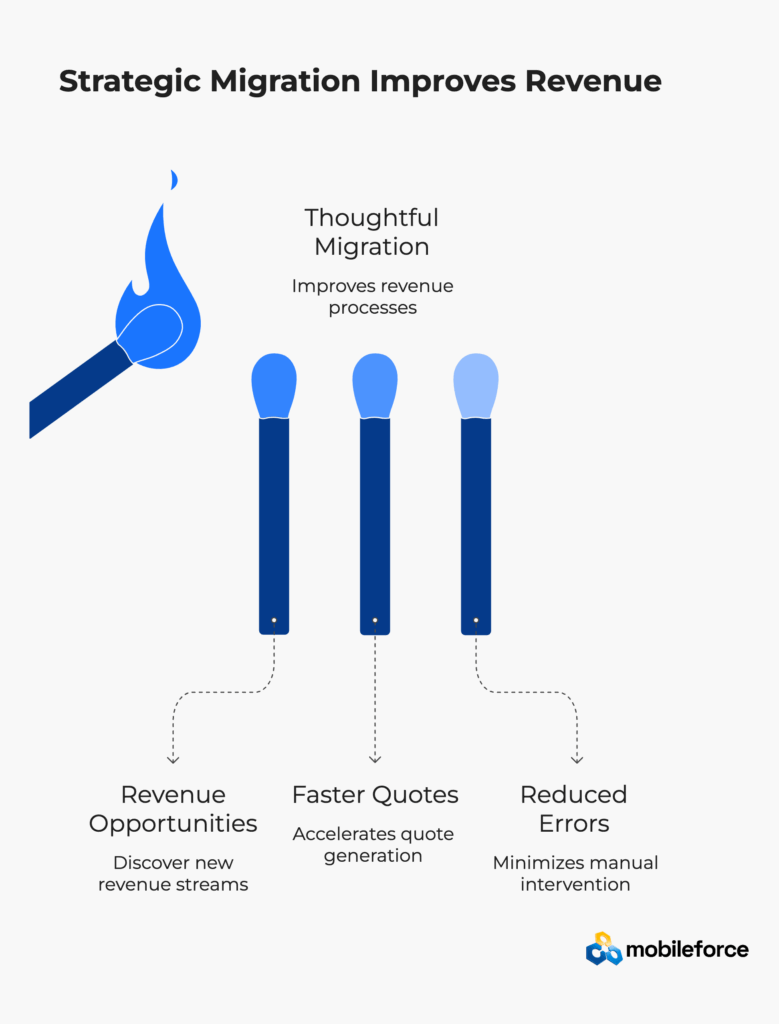
The abstract benefits of modern CPQ become concrete when you examine how organizations have transformed their revenue operations. The patterns are remarkably consistent across industries: companies that successfully modernize their configuration processes don’t just improve efficiency—they unlock entirely new business models.
A global equipment manufacturer was losing deals because their 14-day quote process couldn’t compete with more agile competitors. Their product line included over 50,000 possible configurations, each requiring engineering validation and custom pricing calculations.
After implementing a constraint-based CPQ system, they reduced quote generation from two weeks to same-day delivery. But the real breakthrough came from what the system revealed: 80% of customer requests followed predictable patterns that could be pre-configured and instantly quoted. They transformed from reactive quote generation to proactive solution recommendation.
The results speak volumes:
A software company with complex licensing and feature combinations found that their sales team spent 60% of their time on configuration questions rather than strategic selling. Customers waited days for quotes on products that should have been instantly available.
Their modern CPQ implementation included a customer-facing portal where prospects could configure solutions, see real-time pricing, and generate quotes without sales intervention. The transformation was dramatic:
The lesson from these transformations is clear: when configuration complexity becomes manageable, it transforms from a constraint into a competitive advantage. Organizations that master complex product configuration can offer more customization, respond faster to customer needs, and scale their operations without proportional increases in overhead.
Ready to write your own transformation story? Schedule a consultation to see how Mobileforce can turn your configuration complexity into competitive advantage.
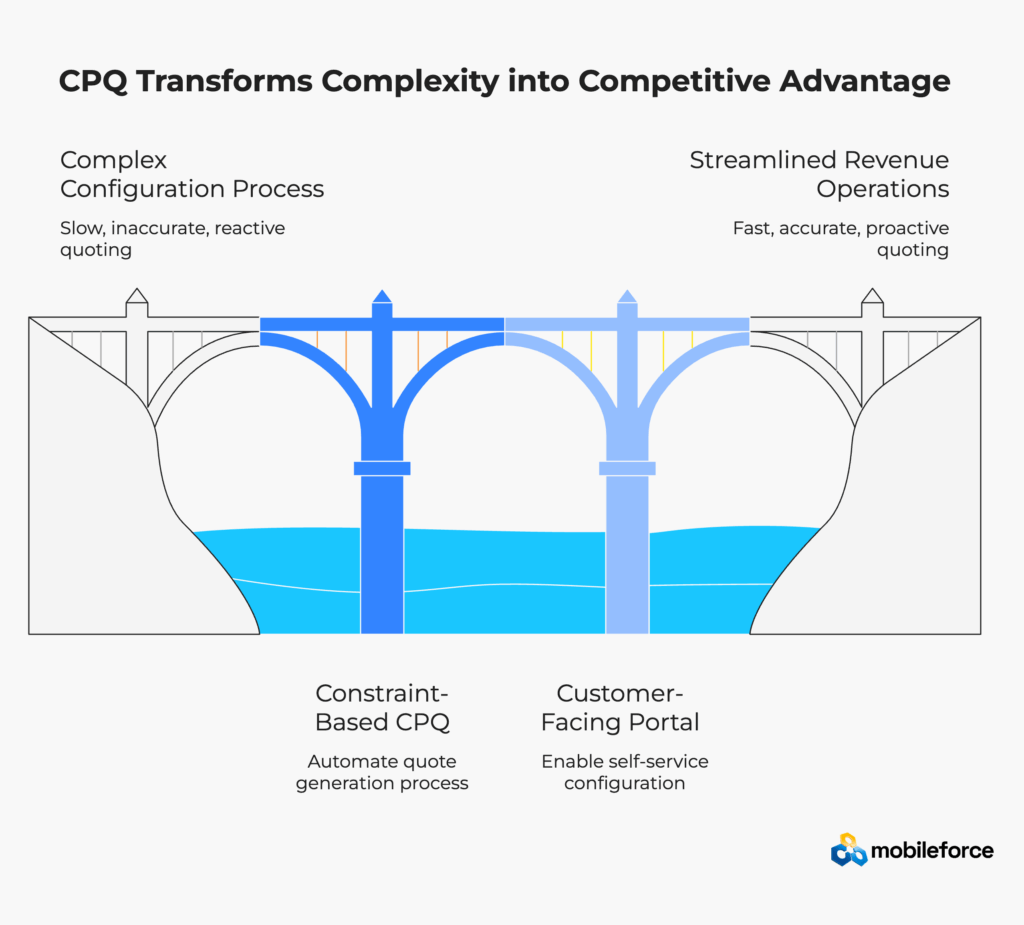
While the CPQ market offers numerous solutions, Mobileforce has carved out a unique position by solving the fundamental tension between power and usability. Most enterprise CPQ platforms require technical expertise to configure and maintain. Consumer-friendly tools lack the sophistication for complex B2B scenarios. Mobileforce bridges this gap with intelligent automation that makes enterprise-grade functionality accessible to business users.
The no-code advantage in practice
Mobileforce’s platform enables revenue operations teams to configure complex product rules, pricing matrices, and approval workflows without writing code or waiting for IT resources. The visual interface guides users through constraint definition while the underlying engine ensures logical consistency and optimal performance.
This isn’t just about ease of use—it’s about speed of adaptation. When market conditions change or new products launch, business teams can update configurations in days rather than months. When customer requirements evolve, pricing strategies can be adjusted in real-time rather than waiting for the next system release. products launch, business teams can update configurations in days rather than months. When customer requirements evolve, pricing strategies can be adjusted in real-time rather than waiting for the next system release.
The platform incorporates machine learning algorithms that analyze configuration patterns, customer preferences, and successful deal structures to provide intelligent recommendations. Sales teams receive real-time suggestions for product combinations that maximize value while ensuring compatibility.
The AI component becomes more valuable over time, learning from every interaction to improve recommendations, identify optimization opportunities, and predict configuration issues before they impact customers.
Despite its user-friendly interface, Mobileforce maintains enterprise-grade capabilities for integration, security, and performance. The platform connects seamlessly with leading CRM systems, ERP platforms, and financial management tools while maintaining SOC 2 compliance and bank-level security.
Field service teams benefit from mobile access to configuration tools, enabling on-site customization and immediate quote generation. Partner organizations gain controlled access to configuration capabilities while maintaining pricing integrity and approval workflows.
The platform’s architecture scales from small teams to global enterprises without compromising performance or requiring infrastructure investment.
|
Mobileforce Advantage |
Traditional CPQ |
Mobileforce Platform |
|
Configuration Speed |
Hours to days |
Minutes to hours |
|
Business User Access |
Requires IT support |
Self-service capability |
|
Integration Timeline |
6-12 months |
2-4 weeks |
|
Ongoing Maintenance |
Technical expertise required |
Business user manageable |
|
Mobile Accessibility |
Limited or non-existent |
Full featured mobile app |
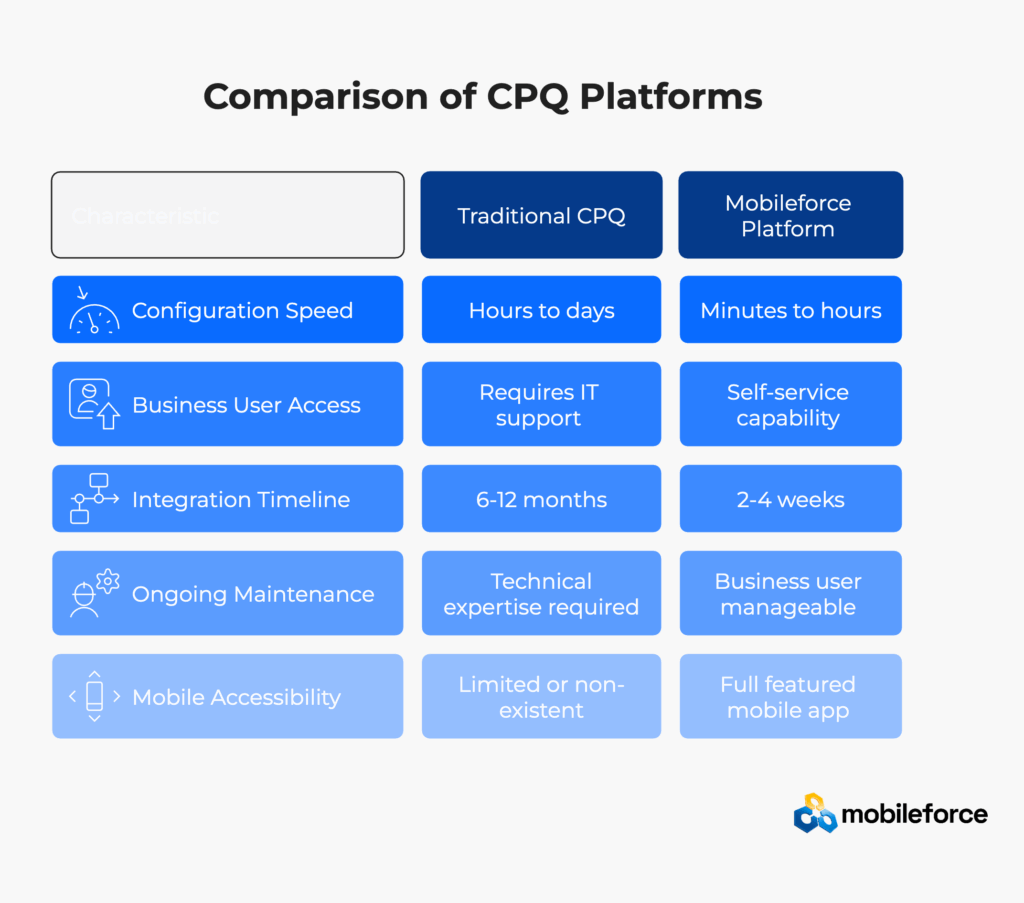
The CPQ landscape continues evolving rapidly, driven by advances in artificial intelligence, changing customer expectations, and increasing product complexity. Organizations investing in configuration capabilities today need solutions that can adapt to tomorrow’s requirements without fundamental rebuilding.
Artificial intelligence is moving from nice-to-have to must-have in configuration management. Future CPQ systems will not just validate configurations—they’ll proactively recommend optimal solutions based on customer context, market conditions, and business objectives.
Industry research indicates that 90% of enterprise applications will incorporate AI by 2025. For CPQ systems, this means intelligent pricing optimization, predictive configuration recommendations, and automated approval workflows based on risk assessment algorithms.
B2B buyers increasingly expect B2C-style self-service capabilities. They want to explore product options, configure solutions, and receive pricing information without requiring sales interaction for every question. This trend accelerated during the pandemic and shows no signs of reversing.
Future configuration platforms must balance self-service convenience with the complexity controls that prevent invalid configurations and protect profit margins. The solution lies in intelligent guardrails that guide customers toward optimal solutions while maintaining business rules and approval requirements.
Modern revenue operations span an expanding ecosystem of specialized tools: CRM for customer management, ERP for fulfillment, contract management for legal compliance, business intelligence for analytics, and emerging tools for customer success, revenue optimization, and predictive analytics.
Successful configuration platforms must serve as integration hubs that connect these diverse systems while maintaining data consistency and workflow continuity. The future belongs to platforms that can orchestrate complex business processes across multiple systems without requiring custom development for each integration.
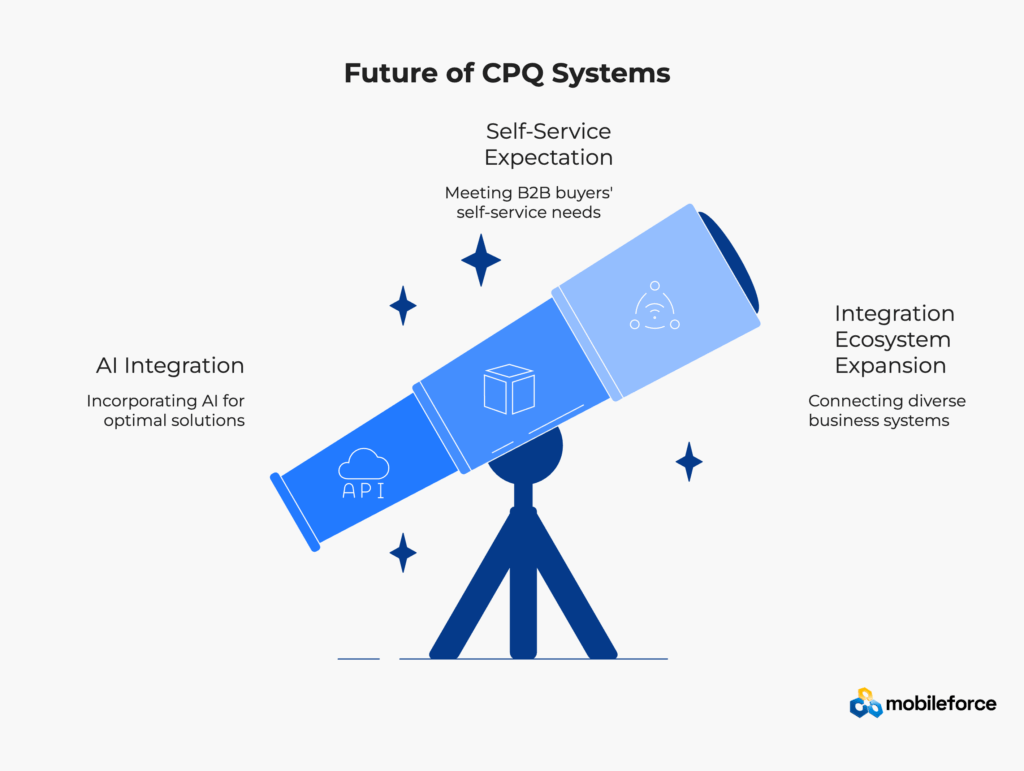
The difference between organizations that thrive with complex product configuration and those that struggle isn’t just technology—it’s approach. The most successful implementations combine smart technology choices with operational excellence and strategic thinking.
The biggest mistake in CPQ implementation is trying to capture every possible configuration scenario upfront. Instead, focus on the 80% of cases that drive 80% of revenue, then iterate based on real usage patterns and customer feedback.
Start with core product lines and standard configurations. Build in flexibility for customization but don’t try to anticipate every possible requirement. The goal is speed and accuracy for common scenarios, with escalation paths for unusual requests.
Complex products require configuration governance, but governance doesn’t have to mean slow approval processes. Establish clear rules for what can be auto-approved, what requires review, and what needs special handling.
Use data to optimize approval thresholds. If 95% of deals under $50,000 with standard configurations get approved anyway, automate those approvals and focus human attention on exceptions that require judgment.
Technology adoption fails when users fall back to familiar processes under pressure. Effective training goes beyond feature explanation to address workflow changes and provide clear value propositions for new behaviors.
Create role-specific training that shows each user group how the new system makes their job easier, faster, or more successful. Sales teams need to see quote speed improvements. Product managers need visibility into configuration patterns. Finance teams need pricing accuracy and margin protection.
What gets measured gets optimized. Establish baseline metrics for quote speed, accuracy, conversion rates, and customer satisfaction before implementing new systems. Track improvements religiously and use data to identify optimization opportunities.
The most valuable metrics often aren’t obvious. Time-to-quote matters, but so does configuration abandonment rate, revision frequency, and approval delay patterns. Use analytics to understand where friction still exists and prioritize improvements accordingly.
|
Best Practice Category |
Key Success Factors |
|
Implementation Strategy |
Start simple, iterate fast, measure everything |
|
User Adoption |
Role-specific training, clear value proposition |
|
Process Integration |
Workflow automation, exception handling |
|
Continuous Improvement |
Data-driven optimization, regular user feedback |
Want to implement these best practices with expert guidance? Connect with Mobileforce’s CPQ specialists for a strategy consultation tailored to your industry and complexity level.
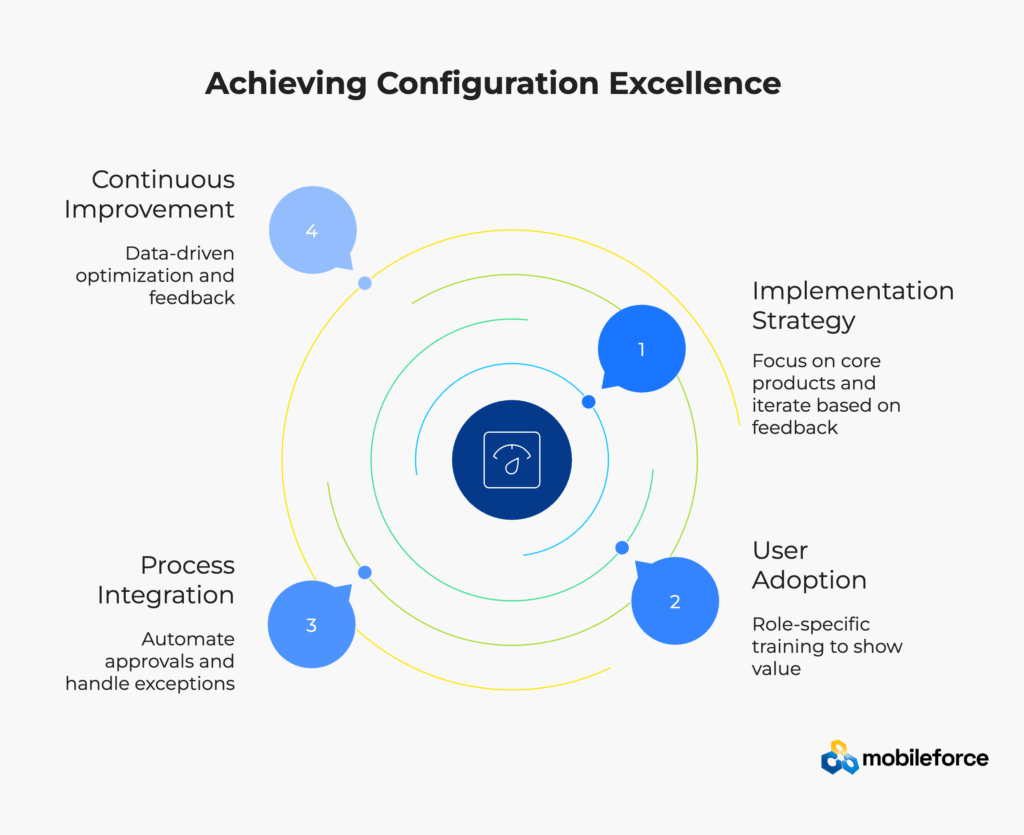
The financial case for modernizing complex product configuration extends far beyond simple cost-benefit analysis. Organizations often focus on operational improvements—faster quotes, fewer errors, reduced manual effort—while missing the strategic revenue implications of configuration excellence.
When configuration processes become frictionless, three revenue drivers activate simultaneously. First, sales velocity increases as quotes generate faster and close rates improve. Second, deal size grows as intelligent recommendations surface higher-value configurations that customers might not have considered. Third, market reach expands as self-service capabilities enable smaller deals that weren’t economically viable with manual processes.
A mid-market software company discovered this multiplication effect firsthand. Their CPQ implementation reduced quote generation time by 65%, but the bigger impact came from configuration insights that revealed underutilized product combinations. By highlighting complementary features during configuration, they increased average deal size by 28% while maintaining margins.
In complex B2B sales, the vendor who can provide accurate quotes fastest often wins regardless of whether they have the best product or lowest price. This first-mover advantage becomes increasingly valuable as buying processes compress and decision-makers demand immediate information.
Organizations with modern configuration capabilities can respond to RFPs in hours rather than days, provide instant pricing for customization requests, and offer real-time alternatives when preferred configurations aren’t available. These capabilities don’t just win individual deals—they position organizations as more professional and capable than competitors still struggling with manual processes.
Smart configuration systems create operational leverage that improves with scale. Each additional product, customer segment, or market geography adds capability without proportional increases in operational complexity. Compare this to manual systems where each new variable multiplies the effort required for accurate quoting.
This leverage effect enables business model innovations that weren’t previously viable. Complex products can be offered through partner channels with confidence in pricing consistency. Self-service options become feasible for customer segments that couldn’t justify dedicated sales resources. Global expansion becomes manageable without duplicating configuration expertise in every region.
|
Economic Impact Category |
Typical Improvements |
|
Sales Velocity |
40-60% faster quote-to-close |
|
Deal Size |
15-30% increase in average order value |
|
Win Rate |
20-35% improvement in competitive situations |
|
Operational Efficiency |
50-70% reduction in quote administration time |
|
Market Expansion |
25-40% increase in addressable opportunities |
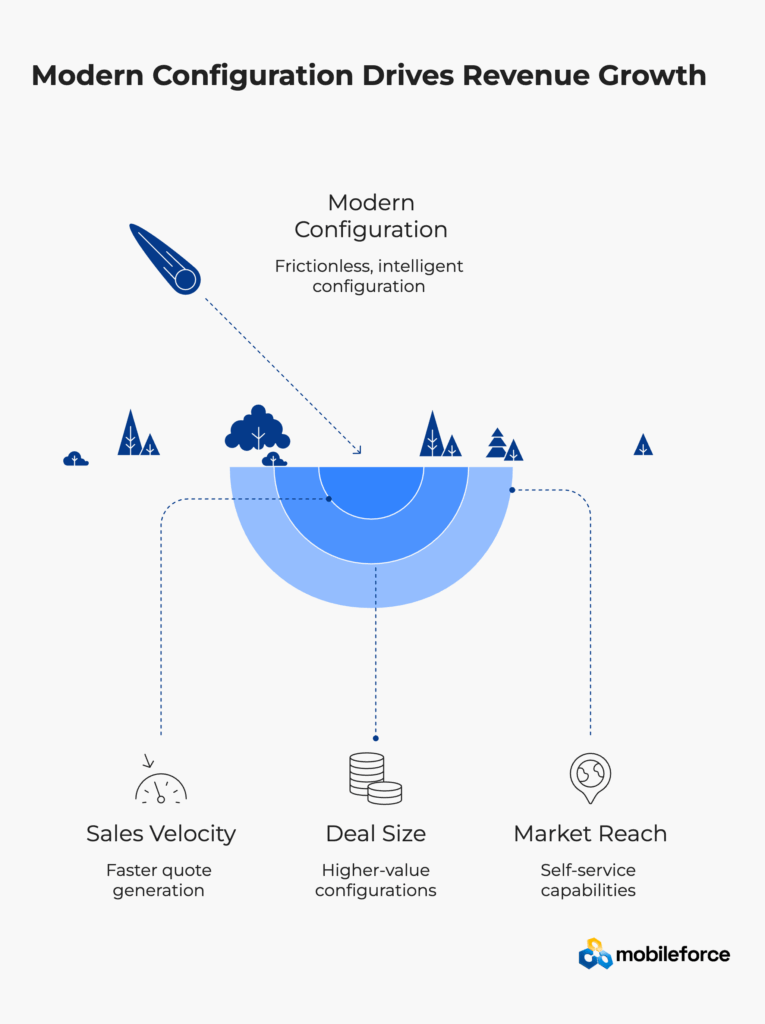
The question isn’t whether to modernize complex product configuration—it’s whether you’ll lead the transformation or react to competitors who move first. The organizations winning in complex product markets understand that configuration excellence isn’t just operational efficiency—it’s strategic differentiation.
Legacy quoting constraints that seemed manageable yesterday become impossible barriers tomorrow as product complexity increases, customer expectations evolve, and competitive pressure intensifies. The CPQ market’s explosive growth to $1.7 billion reflects this reality: companies can no longer compete effectively with manual, constrained quoting processes.
But modernization isn’t just about avoiding competitive disadvantage. It’s about unlocking revenue opportunities that don’t exist with legacy systems. When configuration becomes intelligent, responsive, and user-friendly, it transforms from a cost center into a growth engine.
The path forward requires strategic thinking, not just technology implementation. Organizations that succeed will combine powerful platforms like Mobileforce’s intelligent CPQ solution with operational excellence, user adoption strategies, and continuous optimization mindsets.
The future belongs to organizations that master complexity rather than being constrained by it. Your complex products become competitive advantages when customers can configure them effortlessly, sales teams can quote them accurately, and operations can fulfill them efficiently.
Ready to transform configuration complexity into competitive advantage? Schedule your strategic consultation with Mobileforce’s experts and discover how leading companies are revolutionizing their quote-to-cash processes.
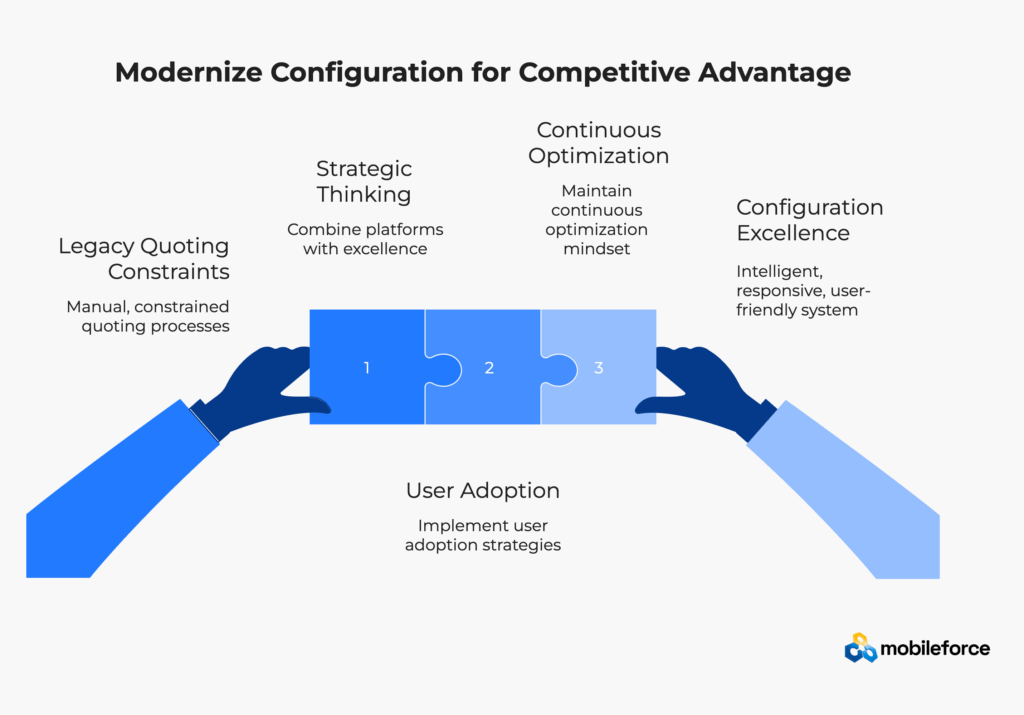
A: Implementation timelines vary based on product complexity and integration requirements, but most organizations see initial value within 8-12 weeks. Mobileforce’s no-code platform can often be deployed in 2-4 weeks for standard configurations, with more complex implementations requiring 2-3 months. The key is starting with a pilot program focused on high-value, manageable product lines rather than trying to migrate everything simultaneously.
A: Rule-based systems use if-then logic to define valid configurations, which becomes unmanageable as complexity increases. Constraint-based engines define what makes configurations invalid and let the system find optimal solutions within those boundaries. This approach scales much better with complex products and enables intelligent recommendations that would be impossible with traditional rule systems.
A: Yes, enterprise CPQ platforms are designed for integration with leading business systems. Mobileforce integrates seamlessly with popular CRM platforms like Salesforce, HubSpot, and Microsoft Dynamics, as well as major ERP systems. The integration typically handles data synchronization, workflow automation, and real-time updates across connected systems.
A: Successful change management focuses on demonstrating clear value to each user group rather than mandating adoption. Start with comprehensive training that shows how the new system makes each person’s job easier. Implement gradually with pilot programs that prove value before full rollout. Most importantly, ensure the new system is obviously better than existing processes—when users see faster quotes and fewer errors, adoption becomes natural.
A: Organizations typically see ROI within 6-12 months through multiple improvement vectors. Sales velocity increases by 40-60% due to faster quote generation. Deal sizes grow 15-30% through intelligent upselling recommendations. Error rates drop by 80-90%, reducing costly mistakes and rework. The exact ROI depends on your current process efficiency and product complexity, but industry studies consistently show significant improvements across all metrics.
A: Modern CPQ platforms like Mobileforce are designed to scale from small teams to global enterprises. Smaller companies often see faster ROI because they can implement more quickly and have fewer legacy system constraints. The key is choosing a platform that provides enterprise capabilities without enterprise complexity. Cloud-based, no-code solutions make advanced configuration functionality accessible to organizations of any size.
A: Leading CPQ platforms maintain enterprise-grade security standards including SOC 2 compliance, data encryption, and regular security audits. Mobileforce provides bank-level security with single sign-on (SSO) and role-based access control (RBAC). When evaluating platforms, verify their compliance certifications, data handling practices, and security track record. Cloud-based systems often provide better security than on-premise solutions due to dedicated security teams and continuous updates.
A: Modern CPQ platforms are designed for mobile accessibility, enabling field sales teams to configure products and generate quotes on-site. Mobileforce’s mobile capabilities include full configuration functionality, real-time pricing, and immediate quote generation from any device. The mobile revolution in sales demonstrates how mobile CRM and CPQ solutions empower field teams with optimized tools that work seamlessly across devices. This capability is particularly valuable for field service organizations and sales teams who work directly with customers at their locations.